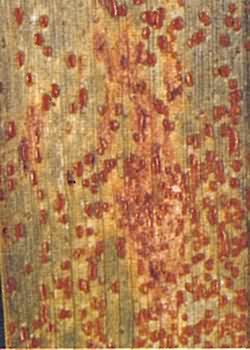Diseases
Puccinia recondita Rob. ex Desm. f. sp. tritici - Wheat leaf (brown) rust.
Systematic position.
Kindom Fungi, division Basidiomycota, class Urediniomycetes, oder Uredinales, family Pucciniaceae.(http://www.indexfungorum.org)
Biological group.
Biotroph.Biology and morphology.
P.recondita is a two-host parasite with complete life cycle, and has five types of sporulation. In the vegetative phase of the life cycle it exists as dikaryotic mycelium, aeciospores, teliospores and urediniospores. In the uredial stage, it passes to wheat plants and wild cereals. Several generations alternate, and quantity depends on climatic conditions of year and duration of vegetation period. Urediniospores are single-celled, have two haploid nucleus composing synkarion. Host maturity and aging of uredial initiate the formation of telio sori with teliospores. The last are two-celled, each cell contains two haploid nuclei. Uredio- and teliospores are adapted to overwintering. In the spring teliospores germinate and yield a basidium in which the fusion of nuclei takes place, resulting in formation of diploid nucleus. Four one-nuclear basidiospores form after meiosis, differing in mating type. Basidiospores infect the intermediate host-plants Thalictrum minus, T. speciosissimum and T. flavum, where the yellow-orange spermogonium is formed with spermatii of two mating types. Mixed mycelia is formed when spermatii are transferred from one spermogonium in another, and dikaryotic cells and aeciospores arise as a result of the formation of anastomoses which infect wheat. The fungus has mainly an incomplete life cycle, reproducing basically asexually, though Thalictrum species occur widely in some areas (Ukraine, the Caucasus etc.) and, thus, the sexual process can play some role in renewal and variability of populations. The weed Isopyrum fumaroides serves as an intermediate host in East Siberia. Teliospores germinate there in September, and basidiospores infect I. fumaroides and form wintering mycelium. Clematis manchurica can also serve as an intermediate host (family Ranunculaceae) in the Far East. P. recondita in the asexual phase of life cycle infects plants of genera Aegilops, Secale, Hordeum, Elymus, Agropirum, and Bromus, in addition to wheat.Distribution.
Wheat leaf rust is distributed everywhere in the world in regions of wheat growth. On the territory of the former USSR the leaf rust occurs in all zones of winter and spring wheat growing.Ecology.
The leaf rust pathogen P. recondita overwinters in Russia as mycelium mainly in leaves of winter wheat and wild cereals. The presence of condensed moisture is necessary for uredospore germination, therefore the infection development is promoted by plentiful dews. The infection process is completed in 6 to 8 hr under optimal temperatures between 15 and 25 C, and the next uredospore generation forms in 7-10 days. The greatest development of the disease is observed during the phase of wheat flowering. Uredospores are distributed by the wind. It is known that there is a uniform pathogen population in Europe, and that the Western Siberian population is independent of the European one. This is supported by data of population structure of virulence and by monitoring uredospores transportation by air streams.Economic significance.
The wheat leaf rust causes an essential loss to yield of grain in Russia, especially in the Volga Basin, North-Caucasian and Central Chernozem Regions, where it occurs practically annually, quite often reaching epidemic levels. Epidemics occur with a frequency of 2-3 times per 10 years in the North-Caucasian Region (5 times per 10 years till 1996), 3-4 times in Central-Chernozem and Central Regions, 6 times in the Volga Basin Region, and 3 times in 10 years in the Volga-Vyatka region. In the Ural region the disease attack on the spring wheat is observed annually with an infection rate of 30-40%.Reference citations:
Lebedev V.B. 1998. Rust of wheat in the Lower Volga. Saratov: Agricutural University. 296 pp.Mikhailova L.A. 1996. Structure of populations of the wheat brown rust pathogen on the territory of CIS. V. Areas of populations and direction of spore migration. Mikologiya i fitopatologiya 30(4): 84-90.
Novozilov K.V., Zakharenko V.A., eds. 2000. Levels and tendencies of variability of species composition and intrapopulation structure, areas of complexes of harmful and useful organisms and forecast of dangerous phytosanitary situations in zones of the country. St. Petersburg: VIZR. 100 pp. (In Russian)
Peresypkin V.F. 1969. Agricultural Phytopathology. Moscow: Kolos. 479 pp.
Rozanov Yu.L. 1983. The transport of brown rust spores under various meteorological conditions and synoptical situations. In: Epiphytoties of agricultural crops and their forecasting and preventative measures. 1. Phytopathological forecasting as a base of rational system of plant protection. Proceedings of a scientific conference. Kobuleti. 51-58 pp.
Stepanov K.М. 1940. Overwintering of wheat brown rust (Puccinia recondita Er.). Vestnik zashchity rastenii, No. 5: 109-124.
© Mikhailova L.A.


